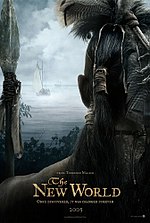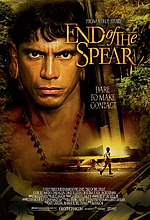
Knight at the Movies ARCHIVES
Men on a Mission:
The New World and End of the Spear
1-18-06 EXPANDED EDITION OF Knight at the Movies/Windy City Times column
by Richard Knight, Jr.
The New World and End of the Spear
1-18-06 EXPANDED EDITION OF Knight at the Movies/Windy City Times column
by Richard Knight, Jr.
Terrence Malick's quiet masterpiece, an out gay actor adds resonance to a story of Christian missionaries


Enigmatic, elusive screenwriter and director Terrence Malick has released his first film in seven years. That alone makes The New
World worth at least a cursory look. We are lucky it’s come this quickly – he took a 20 year break from filmmaking between his
1978 masterwork Days of Heaven and The Thin Red Line, his “war” picture. Whatever the reason for the lag time between pictures,
Malick, the “J.D. Salinger” of directors, has rightfully been hailed for his unique vision. But he’s also been vilified – for Malick makes
slow, quiet epics that are so intensely focused they sometimes seem to be happening in real time. The pacing of his movies can
seem static, the performances of his actors leaden as they speak his few lines of dialogue (there are never many in his movies – he
is the pithiest of screenwriters). Yet, every time I watch one of his pictures I enter a strange, seemingly alternate universe that
allows me to see with new eyes and hear with new ears.
With The New World, Malick delivers another breathtaking, contemplative film that’s going to thrill some and bore the pants off a lot
of others. I think it’s a masterpiece and it cast a spell over me but I’m aware that I’m surrounded by moviegoers who don’t
understand the fuss over Citizen Kane, can’t figure out all the hosannas for The Night of the Hunter, and probably sat through Days of
Heaven (if they’ve even heard of it) because Richard Gere was in it. I, on the other hand, felt that Gere was the one misstep in an
otherwise perfect film.
There are stars at the helm in The New World, too. And again, heartthrobs Colin Farrell and to a lesser degree, Christian Bale, are
the reason people will head out to see this new Malick picture. But unlike Gere in Days of Heaven, Farrell and Bale aren’t nearly as
central to Malick’s vision. This is not the story of a tragic love triangle set against the canvas of a large landscape. Instead, it’s a
much more elliptical film – working, as usual for Malick, on a subconscious level.
The surface story of explorer Captain John Smith (Farrell) and his British brethren colonizing America in 1607 and their interaction
with the Native Americans they encounter, including Farrell’s romance with Pocahontas (Q'Orianka Kilcher), slowly gives way to
something much deeper. The gradual loss of innocence, the disregard for Native American culture and spirituality (not to mention
property rights) and the absolute assurance that these “visitors” bring to their silent take over of this new land is a quiet motif that
Malick expresses repeatedly.
The visual metaphor of Pocahontas running barefoot through the fields one moment and much latter, nearly hobbled when she puts
on a pair of shoes and the constricting clothes of her “conquerors” (done in the name of love) almost says it all. Malick has used
this technique throughout all his films and it’s as strong as ever here. What other filmmaker can express so much with a single
close up of a shoe? Elicit such strong emotions by the sound of wind coursing through a field of tall grass? This is a filmmaker that
literally stops to smell the roses.
The film is basically broken into two sections (like The Thin Red Line). The first half tracks the course of the romance between Smith
and Pocahontas and the concurrent truce that descends into war between the British and Native Americans. Farrell as Smith, first
encountered in the brig of one of the ships for one of his repeated infractions, we are given to understand, is a natural born leader,
who is left in charge of the settlers while his commander (Christopher Plummer) sails back to England, vowing to return with supplies
and more settlers.
But the men are out of their element and the Native Americans, convinced they’ll soon leave, help them out after a good initial
encounter with Smith (and some urging from Pocahontas as well). During the fall months, things go well enough and Smith slowly
falls for the mostly silent and strikingly alluring Pocahontas (and she with him). But by the first winter, when the men are literally
starving to death, the food the Indians arrive with turns the first Thanksgiving into a rescue mission. Naturally, when Plummer and
company return, the rescue mission becomes a complete usurpation of the Native American’s land and Smith himself is sent away.
In his place comes John Rolfe (Christian Bale) who also falls for Pocahontas in Smith’s absence and though a love triangle
momentarily appears when Smith returns, it is Rolfe who marries her (against her better instincts) and eventually returns to England
with her for a visit. She is naturally a sensation but not even a final meeting with Smith seems to phase her. By that point, the
mostly silent Pocahontas seems to finally have an awareness of all that she has given up and all that she has lost. Not surprisingly,
the film ends awash in a melancholy of regret. But then, what Malick film hasn’t?
The actors do a fine job. But with the exception of Kilcher (in her debut), with her arresting features and physical grace, they leave
little impression – good or bad. There is nothing here that resonates like Sissy Spacek’s monotone in Badlands, Linda Manz’s
Brooklyn tough girl terseness or Brooke Adams wracking sobs in Days of Heaven. Typical Malick hallmarks are in place, though,
including his use of quiet interior monologues to tell parts of the story that can’t be explained visually. The stunning
cinematography this time comes courtesy of Emmanuel Lubezki (not surprising – he also shot Lemony Snickett’s and Sleepy Hollow,
among others). Finally, there is Malick’s repeated classical music motif. This time out he favors Richard Wagner’s “Das Rheingold”
and uses it at several key points throughout the film. It blends beautifully with James Horner’s majestic score.
Finally, the version of The New World that I saw was approximately 20 minutes longer than what is now being released. I don’t know
that that’s going to make much of a difference with audiences. No matter the length, Malick's world is not a place that everyone is
going to want to spend time in. But like certain films – Bergman’s Fanny & Alexander, Fellini’s La Dolce Vita, Gance’s Napoleon, for
example – I’m ready to be transported for as long as Malick wants to take me away. I eagerly await the five hour cut.
+++++++++++++++++++++++++++++++++++++++++++++++++++++++++++++++++++++++++++++++++++++++++++++
End of the Spear is the true story of a group of Christian missionaries who were murdered in 1956 in Ecuador. As the film tells us,
this group, led by airplane pilot and natural leader Nate Saint (Chad Allen) are determined to reach out to the violent Waodani tribe.
Through a tragic misunderstanding, Micanyani (Louie Leonardo), the leader of the tribe and his followers, spear to death Saint and
four of his fellow missionaries. But incredibly, Saint’s widow, children, sister and other missionaries turn the other cheek and
eventually help the Waodani dispel their distrust of outsiders (and accept Christianity in the process) and realize that they must give
up their history of violence and put down their spears once and for all.
The film, which seems to begin in the middle of the story, is extremely confusing at first, making it hard to understand the
circumstances that lead to the death of Saint and his colleagues. Saint’s sister fluently speaks the language that will break down the
barriers between the missionaries and the Waodani and barely a reason is given why she’s not informed of the missionaries contact
with the tribe. Also, it’s never really clear why these folks are so intent on making contact with the Waodani to begin with. Especially
when we learn that these are missionaries and not anthropologists (that at least would have made their elusive search for the tribe
make sense).
More interesting than the workmanlike film, which is highlighted by the energetic performance of Allen (as both father and son) and
Leonardo as the hothead Micanyani, however, is that openly gay actor Allen (and staunch supporter of gay marriage) is starring in a
movie financed and pitched to a Christian audience. This irony has been causing a bit of internet buzz. But there’s a much more
interesting fact that hasn’t seemed to cause a peep as of yet. That is the fact of a gay actor portraying a straight character – and a
married one with kids to boot – in a feature film (albeit, an independent one). That the charismatic Allen pulls this off without a hint
of his “shocking” real life, natural proclivities in evidence is the real news here. I hope it catapults him all the way up the box office
leading man ladder. Wouldn’t it be great to see Allen tackle an action picture, romance a honeyed blonde onscreen like Charlize or
Tara, and read in Vanity Fair about his life at home with his…husband?
